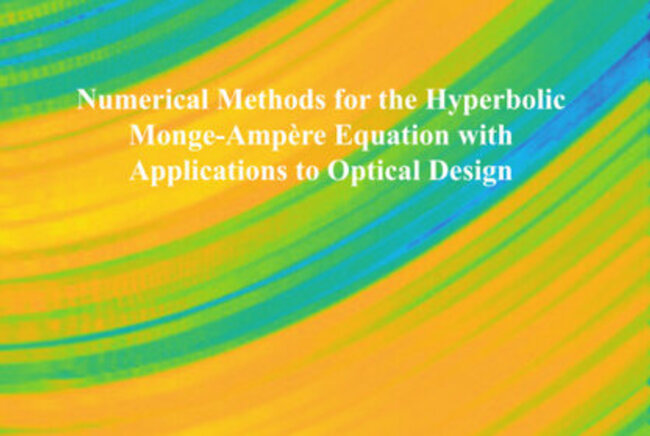New methods to design optical systems
Combining hyperbolic and elliptic solutions adds additional flexibility.

Ever wondered about the design of the headlights of a car? This example of an optical system consists of LED light sources, lenses and how the light looks on the street. More generally, an optical system consists of light sources, some optical and a target distribution. Designing the optical elements was the main goal of the conducted research by Maikel Bertens. He defended his thesis on September 27.
In recent years this design was enabled by solving a differential equation called the Monge-Ampère equation. The solutions to the Monge-Ampère equation then describe the optical elements and, practically, come in two variants, elliptic and hyperbolic. Methods for finding elliptic solutions are plentiful and well-studied. These solutions do resemble parts of a sphere. However, methods to find hyperbolic solutions are scares and less well known in the literature. Furthermore, the solutions do resemble saddles shapes. Combining these hyperbolic and elliptic solutions will add additional flexibility to the design of optical systems and may allow for totally new designs. Therefore, the first aim was to develop methods for the hyperbolic Monge-Ampère equation.

The method of characteristics
The first developed method for the hyperbolic Monge-Ampère equation was the method of characteristics. Using this method, the Monge-Ampère equation is rewritten as a group of coupled, but simpler equations. This group of equations is solved numerically, i.e., approximating the solution using computer algorithms. As usual for numerical algorithms, a better approximation takes longer to compute, though Bertens shows that his method, given long enough time, does compute the solution he was aiming for.
Next, he tried applying this method of characteristics to the design of optical systems. For this design, a requirement exists that the light of the boundary of the light source needs to end up at the boundary of the target. This requirement is called the transport boundary condition. Unfortunately, Bertens was not able to reconcile the transport boundary methods with the method of characteristics. Therefore he searched for a new method for the hyperbolic Monge-Ampère.
Minimizations carried out one after the other
The new method found was the a so-called least-squares method. The least-square solver had already proven to work for the elliptic Monge Ampère equation with transport boundary conditions, and was therefore extended to work for the hyperbolic case. The method relies on formulating the problem as a minimization problem. To this end, Bertens developed a minimization for the interior of the light source, a minimization for the transport boundary condition and a minimization for the total error. These minimizations are carried out one after the other until we are sufficiently pleased with the numerical solution.
Lastly, he applied this least-square solver to designing optical systems with parallel light sources, which, for example, model lasers. For this he considered light to behave as straight lines called rays. It was found that at least four distinct optical systems can be obtained for the same optical problem. Two of these systems are solutions to the elliptic Monge-Ampère equation and two are solutions to the hyperbolic problem. These optical elements do indeed resemble parts of a sphere or saddle.
Title of PhD thesis: Numerical Methods for the Hyperbolic Monge-Ampère Equation with Applications to Optical Design
Supervisors: prof.dr.ir. Wilbert IJzerman, dr.ir. Jan ten Thije Boonkkamp and dr.ir. Martijn Anthonissen.
Media contact
Latest news
![[Translate to English:] [Translate to English:]](https://assets.w3.tue.nl/w/fileadmin/_processed_/9/4/csm_predatory_fe539af8af.jpg)


![[Translate to English:] [Translate to English:]](https://assets.w3.tue.nl/w/fileadmin/_processed_/e/0/csm_BvOF%202019_1031_BHF%20license%20TUe%20ILI%20copy_b6b93f2ef4.jpg)

